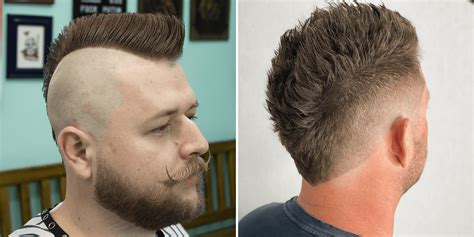The faux hawk and mohawk are two bold and edgy hairstyles that have commanded attention for decades. While they share certain similarities, these styles also possess distinct differences that set them apart. This comprehensive comparison will delve into the defining characteristics, history, and cultural significance of both hairstyles, helping you make an informed choice when considering a bold new look.

Faux Hawk: The Hybrid Hairstyle
A faux hawk is a hybrid hairstyle that combines elements of a mohawk and a crew cut. It features shaved or buzzed sides with a longer strip of hair running down the center of the head, creating an illusion of a mohawk without actually shaving the sides of the head. The length of the central strip can vary, allowing for customization and adaptation to different hair types and facial structures.
Key Characteristics:
- Shaved or buzzed sides
- Longer central strip
- Creates the illusion of a mohawk without shaving the sides
Mohawk: The Native American Icon
The mohawk is an iconic hairstyle deeply rooted in Native American culture. It involves shaving the sides of the head and leaving a narrow strip of hair running from the forehead to the nape of the neck. The central strip can be styled in various ways, such as spikes, braids, or elaborate designs. Traditionally, the mohawk represented strength, bravery, and readiness for battle.
Key Characteristics:
- Shaved sides
- Central strip of hair from forehead to nape of neck
- Historical significance in Native American culture
- Can be styled in various ways
History and Cultural Significance
The origins of the faux hawk can be traced back to the 1980s punk rock scene, where it emerged as a symbol of rebellion and individuality. It gained further popularity in the 1990s with the rise of grunge and alternative rock. In recent years, the faux hawk has become more mainstream and is often seen in sports, fashion, and entertainment.
The mohawk has a much longer history, dating back to ancient Native American tribes. It was a symbol of honor, strength, and readiness for battle. Each tribe had its own unique style and variations of the mohawk. In the 1970s, the mohawk experienced a revival as a symbol of punk rock rebellion. It remains a popular hairstyle among subcultures, such as heavy metal fans and motorcyclists.
Versatility and Customization
Both the faux hawk and mohawk offer a high degree of versatility and customization. The faux hawk can be adapted to different hair types and face shapes by adjusting the length of the central strip. The mohawk can be styled in various ways, from classic spikes to elaborate braids and designs. This allows both hairstyles to complement different personal styles and preferences.
Common Mistakes to Avoid
When styling a faux hawk or mohawk, certain mistakes should be avoided to ensure a clean and flattering look. These include:
- Uneven shaving: Ensure the sides of the head are shaved evenly to create a sharp contrast with the central strip.
- Over-styling: Avoid over-styling or using excessive hairspray, which can make the hairstyle look unnatural and stiff.
- Neglecting hair care: The central strip of the faux hawk or mohawk requires proper care and maintenance. Regular washings, conditioning, and trimming are essential to keep the hair healthy and looking its best.
How to Style a Faux Hawk or Mohawk
Styling a faux hawk or mohawk can be a relatively simple process with the right tools and techniques. Here is a step-by-step guide:
- Wash and condition hair: Begin with clean, damp hair.
- Shave the sides: Use a razor or clippers to shave the sides of the head, leaving a narrow central strip.
- Style the central strip: For a faux hawk, use a hairbrush or comb to create a central strip of the desired length. For a mohawk, style the strip with spikes, braids, or other creative designs.
- Secure the style: Use hairspray or gel to hold the style in place.
- Finish with a trim: Once the style is set, trim any stray hairs for a polished look.
Tips and Tricks
- Experiment with different styling products to achieve the desired hold and texture.
- Consider hair extensions if you desire a longer central strip for a faux hawk.
- Use a hair dryer to add volume to the central strip of a mohawk.
- Accessorize with headbands, bandanas, or jewelry to enhance the style.
Table 1: Comparison of Faux Hawk and Mohawk Characteristics
| Feature | Faux Hawk | Mohawk |
|---|---|---|
| Sides | Shaved or buzzed | Shaved |
| Central strip | Longer, varied length | Narrow, varies in width |
| Origin | 1980s punk rock | Native American culture |
| Cultural significance | Rebellion, individuality | Strength, bravery, readiness for battle |
Table 2: Versatility and Customization Options
| Hairstyle | Customization Options |
|---|---|
| Faux Hawk | Length of central strip, styling of central strip |
| Mohawk | Width of central strip, styling techniques (spikes, braids, designs) |
Table 3: Common Mistakes to Avoid
| Mistake | Result |
|---|---|
| Uneven shaving | Sloppy appearance |
| Over-styling | Unnatural, stiff look |
| Neglecting hair care | Dry, damaged hair |
Table 4: Styling Techniques
| Hairstyle | Technique |
|---|---|
| Faux Hawk | Brush or comb central strip |
| Mohawk | Style central strip with spikes, braids, or designs |
Conclusion
The faux hawk and mohawk are both striking hairstyles that embody rebellion, individuality, and style. The faux hawk offers a more versatile and adaptable option, while the mohawk retains its historical and cultural significance. Whether you choose the edgy faux hawk or the iconic mohawk, embrace the boldness and express your unique personality through your hairstyle.
